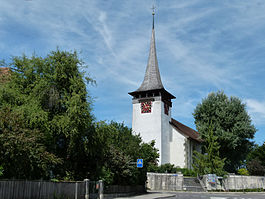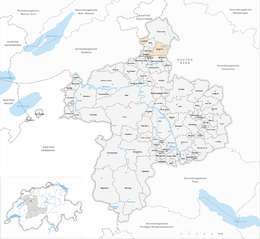Jegenstorf
| Jegenstorf | ||
|---|---|---|
 |
||
|
||
| Coordinates: 47°3′N 7°30′E / 47.050°N 7.500°ECoordinates: 47°3′N 7°30′E / 47.050°N 7.500°E | ||
| Country | Switzerland | |
| Canton | Bern | |
| District | Bern-Mittelland | |
| Area | ||
| • Total | 13.5 km2 (5.2 sq mi) | |
| Elevation | 521 m (1,709 ft) | |
| Population (Dec 2015) | ||
| • Total | 5,609 | |
| • Density | 420/km2 (1,100/sq mi) | |
| Postal code | 3303 | |
| SFOS number | 0540 | |
| Surrounded by | Grafenried, Iffwil, Mattstetten, Münchringen, Urtenen-Schönbühl, Zauggenried, Zuzwil | |
| Website |
www SFSO statistics |
|
Jegenstorf is a municipality in the Bern-Mittelland administrative district in the canton of Bern in Switzerland. On 1 January 2010 the former municipality of Ballmoos merged into Jegenstorf and on 1 January 2014 Münchringen and Scheunen merged into Jegenstorf.
Jegenstorf is first mentioned in 1131 as Igistorf. In 1255 it was mentioned as Jegistorf.
The earliest trace of human settlements in the area are several Hallstatt burial mounds which were found on the border with Münchringen. The mounds contain a rich collection of arrowheads, pottery and gold artifacts. The remains of a Gallo-Roman estate, including a wall, parts of pillars, bricks and ceramics, have been discovered near the village church.
During the Middle Ages the village was held by the Zähringen Ministerialis (unfree knights in the service of a feudal overlord) family of Jegenstorf. The Jegenstorfs built a moated castle near the village in the 12th century. When the Zähringens died out, the village became part of the Kyburg court of Zollikofen. A low court was held in front of the Gasthof Kreuz in Jegenstorf. In 1406 Bern acquired many of the Kyburg villages including Jegenstorf. Under Bernese rule, the court continued to be held in front of the Gasthof or Inn.
At some time before 1300, a portion of the Jegenstorf lands were acquired by the Erlach family. In 1300, the Jegenstorf family died out and the remainder of the village passed into other nobles' possession. The Erlachs continued to gain power and in the 15th century acquired the castle, the entire village and the courts. The castle remained under Erlach control until 1584. The Bonstetten family owned it 1584-1675, followed by the Wattenwyl between 1675-1720 and again the Erlach family in 1720-58. Karl Ludwig von Erlach sold the castle and estate in 1758, but kept the right to rule over the village. They held the rulership over the village until the 1798 French invasion when it transferred to the Canton of Bern. In 1810 the Canton compensated the Erlachs for the village.
...
Wikipedia




